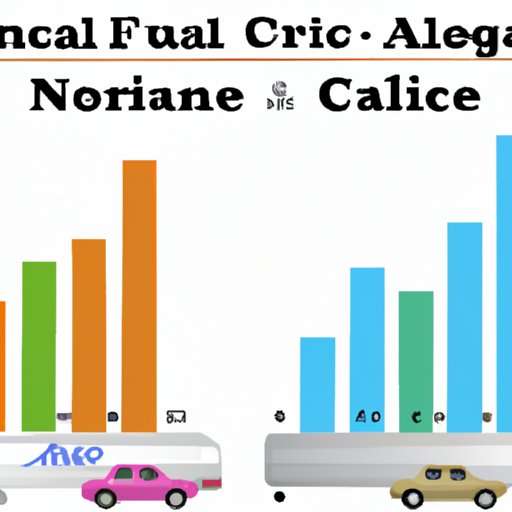Introduction
Health insurance is an important part of life for many people. It can provide financial protection against unexpected medical expenses, help offset the cost of regular preventive care, and make it easier to access quality healthcare. However, health insurance can also be expensive, and the cost of coverage varies significantly from one state to another. In this article, we will explore how much health insurance costs in California, comparing average premiums with those in other states and examining the factors that can influence the cost of coverage.

Comparing Average Health Insurance Costs in California with National Averages
The Kaiser Family Foundation is a nonprofit organization that collects data on health insurance costs across the United States. According to their most recent survey, the average annual premium for employer-sponsored family health insurance coverage in California was $22,404 in 2019, which is slightly below the national average of $22,612. For individual coverage, the average annual premium in California was $6,945, which is higher than the national average of $6,588.
When looking at the trends in California compared to other states, the Kaiser Family Foundation found that the state had the ninth highest average premium for employer-sponsored family coverage in 2019. However, when it comes to individual coverage, California ranked fourth in terms of average annual premiums.

Exploring Factors that Impact the Cost of Health Insurance in California
When it comes to the cost of health insurance in California, there are several factors that can influence the price. These include age, location, type of coverage, and deductible level. Let’s take a closer look at each of these.
Age
Age is one of the most significant factors that can influence the cost of health insurance in California. Generally, younger individuals tend to pay less for coverage than older individuals, as they are seen as being less likely to need medical care. According to the California Department of Insurance, the average monthly premium for an individual aged 18-34 was $204 in 2019, while the average monthly premium for an individual aged 55-64 was $420.
Location
The location where you live can also play a role in the cost of your health insurance. Premiums may be higher or lower depending on the area, as some regions have higher costs of living and more expensive healthcare services. For example, the average monthly premium for an individual in San Francisco was $279 in 2019, while the average monthly premium for an individual in Fresno was $225.
Type of Coverage
The type of coverage you choose can also affect the cost of your health insurance. Generally speaking, plans with more comprehensive coverage will cost more than plans with less coverage. In addition, some plans may offer additional benefits, such as vision and dental coverage, which can increase the cost of the plan.
Deductible Level
Your deductible is the amount of money you must pay out-of-pocket before your health insurance kicks in and begins covering the cost of your care. Higher deductibles typically mean lower premiums, so if you are looking to save money on your health insurance, you may want to consider a plan with a higher deductible.

Examining Available Health Insurance Plans in California and Their Costs
In California, there are several types of health insurance plans available, including HMOs, PPOs, and EPOs. Here’s a quick overview of each type of plan and their associated costs.
Different Types of Plans
HMOs (Health Maintenance Organizations) typically require you to use in-network doctors and hospitals and do not cover out-of-network care. PPOs (Preferred Provider Organizations) offer more flexibility, allowing you to see out-of-network providers, although you may pay more for doing so. EPOs (Exclusive Provider Organizations) are similar to PPOs but require you to use only in-network providers.
Premiums
Premiums are the amount you pay each month for health insurance coverage. The exact cost of your premium will depend on the type of plan you choose, your age, and other factors. On average, premiums range from around $400 per month for an individual to $1,100 per month for a family.
Copays and Coinsurance
In addition to premiums, you may also be responsible for copays and coinsurance. Copays are fixed fees associated with certain services, such as doctor visits, while coinsurance is a percentage of the cost of services that you are responsible for paying. The amount you pay for copays and coinsurance will depend on the type of plan you choose.
An Overview of State Regulations That Impact Health Insurance Costs in California
In California, there are several state regulations that can impact the cost of health insurance. These include the Affordable Care Act, Medi-Cal, and Covered California.
Affordable Care Act
The Affordable Care Act (ACA), also known as Obamacare, is a federal law that requires all Americans to obtain health insurance or face a penalty. Under the ACA, health insurance companies must offer coverage to everyone regardless of pre-existing conditions, and they cannot charge higher premiums based on gender. This has helped to make health insurance more affordable for many Californians.
Medi-Cal
Medi-Cal is California’s Medicaid program, providing free or low-cost health insurance to low-income individuals and families. To be eligible for Medi-Cal, you must meet certain income requirements and reside in the state. Enrollment in Medi-Cal has increased significantly since the implementation of the ACA, helping to reduce the number of uninsured Californians.
Covered California
Covered California is the state’s health insurance marketplace, where individuals and families can shop for health insurance. Through Covered California, you can compare different plans and find one that meets your needs and budget. Covered California also offers subsidies and tax credits to help make health insurance more affordable.
Analyzing the Relationship Between Income Level and Health Insurance Costs in California
Income level is another key factor that can influence the cost of health insurance in California. Low-income individuals and families may qualify for subsidies and tax credits to help reduce the cost of coverage.
Subsidies
Subsidies are discounts on health insurance premiums that are available to individuals and families with incomes up to 400% of the federal poverty level. Subsidies can reduce the cost of coverage by up to 80%, making health insurance more affordable for those who need it most.
Tax Credits
Tax credits are available to individuals and families with incomes up to 400% of the federal poverty level who purchase health insurance through Covered California. Tax credits are applied directly to your monthly premium, reducing the cost of coverage.
Investigating How Employer-Provided Health Insurance Affects Costs in California
Many employers in California offer health insurance as an employee benefit. This can help reduce the cost of coverage for employees, as employer contributions to health insurance premiums are generally tax-deductible.
Employer Contributions
Most employers in California contribute to the cost of their employees’ health insurance premiums. The amount the employer contributes depends on the type of plan selected and the size of the business. Generally speaking, larger businesses are more likely to offer more generous contributions.
Cost-Sharing Arrangements
In addition to employer contributions, some employers in California also offer cost-sharing arrangements with employees. Under these arrangements, the employer and employee each pay a portion of the premium, with the employer usually contributing the majority of the cost. Cost-sharing arrangements can help reduce the cost of health insurance for employees.
Conclusion
The cost of health insurance in California can vary significantly depending on a variety of factors, including age, location, type of coverage, and deductible level. The state also has several regulations in place that can help reduce the cost of coverage, such as subsidies and tax credits for low-income individuals, and employer contributions for those with employer-provided health insurance. By understanding how these factors can affect the cost of health insurance, consumers can make informed decisions about their coverage and ensure they get the best possible deal.
Summary of Key Points
In summary, the cost of health insurance in California can vary significantly depending on age, location, type of coverage, and deductible level. The state also has several regulations in place that can help reduce the cost of coverage, such as subsidies and tax credits for low-income individuals, and employer contributions for those with employer-provided health insurance. Understanding these factors can help consumers make informed decisions about their coverage and ensure they get the best possible deal.
Next Steps for Consumers
If you are considering health insurance in California, the best way to find the right plan for you is to compare different options and decide which one best meets your needs and budget. You can visit Covered California to compare plans and find out if you qualify for subsidies or tax credits. You can also speak to your employer about any cost-sharing arrangements that may be available. Finally, it’s important to remember that health insurance costs may change over time, so it’s important to review your coverage regularly to make sure you’re still getting the best deal.
(Note: Is this article not meeting your expectations? Do you have knowledge or insights to share? Unlock new opportunities and expand your reach by joining our authors team. Click Registration to join us and share your expertise with our readers.)
